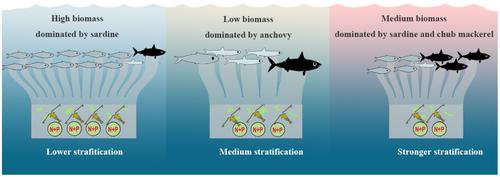当前位置:
X-MOL 学术
›
Fish Fish.
›
论文详情
Our official English website, www.x-mol.net, welcomes your feedback! (Note: you will need to create a separate account there.)
Fish weight reduction in response to intra- and interspecies competition under climate change
Fish and Fisheries ( IF 6.7 ) Pub Date : 2024-02-21 , DOI: 10.1111/faf.12818 Zhen Lin 1 , Shin‐ichi Ito 1
Fish and Fisheries ( IF 6.7 ) Pub Date : 2024-02-21 , DOI: 10.1111/faf.12818 Zhen Lin 1 , Shin‐ichi Ito 1
Affiliation

|
As described by the temperature–size rule paradigm, fish living in warmer temperatures grow faster but have a smaller mature body size. However, the changes in the body size of fish communities in the western North Pacific, which is one of the most active fishing grounds, remain unclear. This study aimed to investigate changes in the body size of fish assemblages in the western North Pacific and whether fish sizes were potentially driven by the temperature–size rule, bottom-up effects and intra- and interspecies competition at a community scale. We evaluated the fish weight data of 6 stocks of 4 species from 1978 to 2018 and 17 stocks of 13 species from 1995/1997 to 2018. Weight reduction in the fish assemblage was observed in the 1980s and was associated with the biomass peak of the Japanese sardine (Sardinops melanostictus), indicating the effect of intra- and interspecies competition. Another weight reduction was observed in the 2010s, which was associated with a moderate increase in the biomass of the Japanese sardine and chub mackerel (Scomber japonicus). Our analyses indicate that stronger stratifications in the surface layers during the 2010s potentially reduced the nutrient supply from the subsurface to the surface layers. This limitation in food availability forced intra- and interspecies competition under a moderate increase in fish biomass. Our findings underscore the critical significance of integrating the impacts of species competition and climate change on fish sizes to improve fishery management at a community level.
中文翻译:

气候变化下鱼类体重减轻应对种内和种间竞争
正如温度-体型规则范式所描述的,生活在较高温度下的鱼类生长得更快,但成熟的体型较小。然而,作为最活跃渔场之一的北太平洋西部鱼类群落体型的变化仍不清楚。本研究旨在调查北太平洋西部鱼类组合体型的变化,以及鱼类体型是否可能由温度-体型规则、自下而上效应以及群落规模的种内和种间竞争驱动。我们评估了 1978 年至 2018 年 6 个种群 4 个物种以及 1995/1997 年至 2018 年 17 个种群 13 个物种的鱼类重量数据。在 20 世纪 80 年代观察到鱼类组合的重量减少,这与日本的生物量峰值有关沙丁鱼(Sardinops melanostictus),表明种内和种间竞争的影响。 2010 年代又观察到体重下降,这与日本沙丁鱼和鲭鱼(鲭鱼)生物量的适度增加有关。我们的分析表明,2010 年代表层更强的分层可能会减少从地下到表层的养分供应。食物供应的这种限制迫使鱼类生物量适度增加的情况下进行物种内和物种间的竞争。我们的研究结果强调了综合物种竞争和气候变化对鱼类大小的影响对于改善社区一级的渔业管理的至关重要性。
更新日期:2024-02-21
中文翻译:

气候变化下鱼类体重减轻应对种内和种间竞争
正如温度-体型规则范式所描述的,生活在较高温度下的鱼类生长得更快,但成熟的体型较小。然而,作为最活跃渔场之一的北太平洋西部鱼类群落体型的变化仍不清楚。本研究旨在调查北太平洋西部鱼类组合体型的变化,以及鱼类体型是否可能由温度-体型规则、自下而上效应以及群落规模的种内和种间竞争驱动。我们评估了 1978 年至 2018 年 6 个种群 4 个物种以及 1995/1997 年至 2018 年 17 个种群 13 个物种的鱼类重量数据。在 20 世纪 80 年代观察到鱼类组合的重量减少,这与日本的生物量峰值有关沙丁鱼(Sardinops melanostictus),表明种内和种间竞争的影响。 2010 年代又观察到体重下降,这与日本沙丁鱼和鲭鱼(鲭鱼)生物量的适度增加有关。我们的分析表明,2010 年代表层更强的分层可能会减少从地下到表层的养分供应。食物供应的这种限制迫使鱼类生物量适度增加的情况下进行物种内和物种间的竞争。我们的研究结果强调了综合物种竞争和气候变化对鱼类大小的影响对于改善社区一级的渔业管理的至关重要性。



























 京公网安备 11010802027423号
京公网安备 11010802027423号